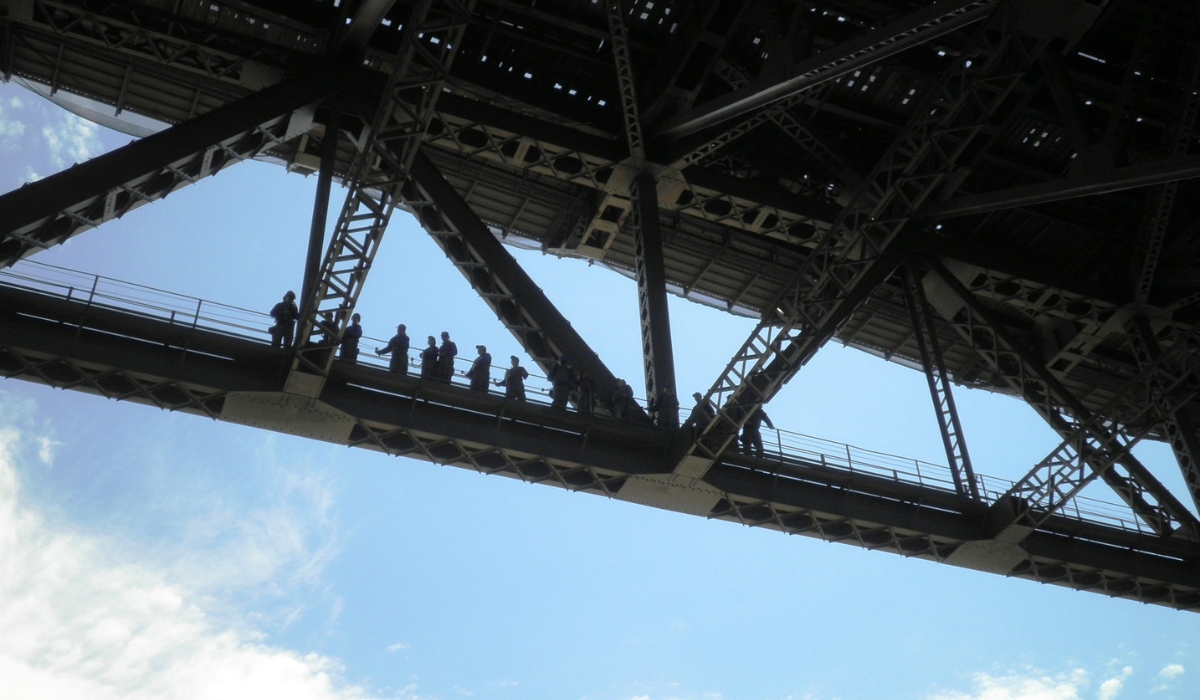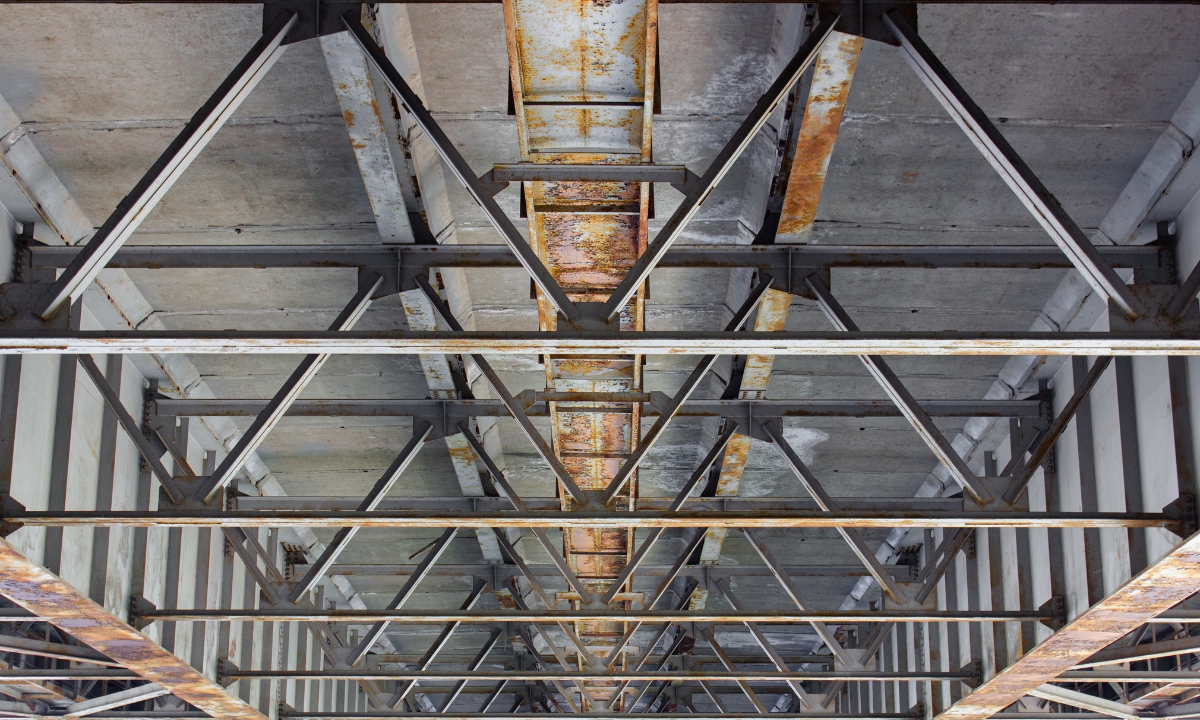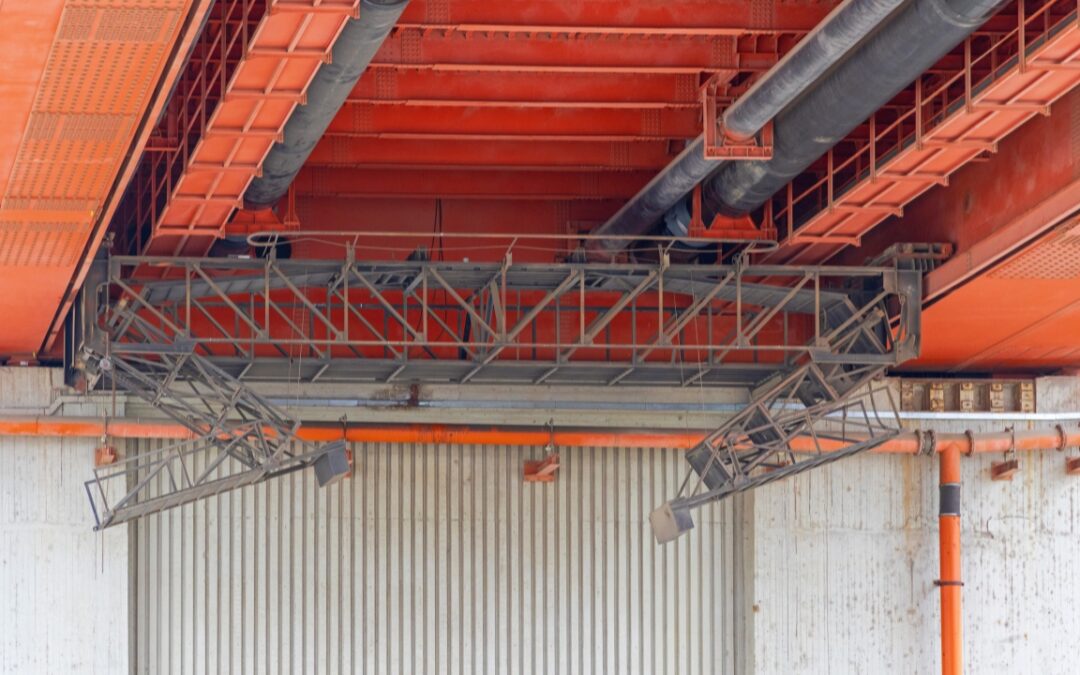The American Society of Civil Engineers (ASCE) gives U.S. bridges a collective grade of C+ . This means a significant portion of our nation’s bridges require repairs, posing safety hazards and causing costly traffic delays. Maintaining and inspecting these bridges has traditionally been a risky and time-consuming process. However, under bridge platforms have emerged as a significant change in infrastructure care.
This article explores why under bridge platforms are the future of bridge inspections, repairs, and maintenance for general contractors, engineers, and bridge inspectors. We’ll delve into the benefits they offer, safety considerations, and the different types of platforms available for rental.

The Challenges of Traditional Bridge Inspection
Inspecting bridges has historically been a complex and dangerous task. Traditional methods often involve:
- Lane Closures: These disrupt traffic flow, leading to congestion and frustration for commuters.
- Snooper Trucks: These large, specialized vehicles can be expensive to rent and operate, and their weight limitations restrict the types of inspections they can perform.
- Rope Access: This highly skilled but risky method requires extensive training and exposes workers to potential falls.
These methods are not only inefficient but also create safety hazards for inspectors and increase project costs.
Under Bridge Platforms: A Safer, More Efficient Solution
Under bridge platforms offer a safer, more efficient alternative to traditional bridge inspection methods. These platforms are suspended underneath bridges, providing a stable work surface for inspectors and crews to perform close-up inspections, conduct repairs, and complete maintenance tasks.
Here’s how under bridge platforms address the challenges of traditional methods:
- Improved Safety: Platforms eliminate the need for lane closures and risky rope access techniques, significantly reducing the risk of falls and worker injuries.
- Increased Efficiency: Platforms provide a stable and accessible work area, allowing inspectors and crews to complete tasks quicker.
- Reduced Costs: By eliminating lane closures and expediting inspections, under bridge platforms can significantly reduce project timelines and associated costs.
- Versatility: Platforms can be customized to fit the specific needs of each bridge, allowing access to hard-to-reach areas for comprehensive inspections.
Benefits for General Contractors, Engineers, and Bridge Inspectors
- General Contractors:
- Enhance safety records with a reduced risk of worker injuries.
- Improve project efficiency and timelines through faster inspections and repairs.
- Reduce project costs by minimizing lane closure times and expediting work.
- Stand out from competitors by offering innovative solutions for bridge projects.
- Engineers:
- Gain safer and more efficient access to bridges for detailed inspections.
- Collect more accurate data due to a stable work platform.
- Improve decision-making with a clearer understanding of bridge conditions.
- Bridge Inspectors:
- Perform inspections with greater ease and confidence on a secure platform.
- Reduce fatigue and improve focus with a comfortable work environment.
- Conduct more thorough inspections due to improved access to bridge components.
Safety Considerations for Under Bridge Platforms
While under bridge platforms offer significant safety advantages, proper safety protocols remain essential. Here are some key considerations:
- Fall Protection: Always use appropriate fall arrest harnesses and lifelines when working on platforms.
- Platform Capacity: Ensure the platform is rated for the weight of workers, equipment, and materials.
- Bridge Stability: Inspect the bridge for any signs of damage that could compromise platform stability.
- Weather Conditions: Do not operate platforms in high winds or inclement weather.
- Qualified Personnel: Only trained and certified personnel should operate and work on under bridge platforms.

Different Types of Under Bridge Platforms for Rental
Under bridge platform rental companies offer a variety of platform configurations to suit diverse bridge inspection and maintenance needs. Here are some common types:
- Suspended Platforms: These platforms hang from the bridge deck using wire ropes or chains, offering access to the underside of the bridge.
- Man-Basket Platforms: These smaller platforms are ideal for one or two inspectors to access specific areas for detailed inspections.
- Work cage Platforms: These larger platforms provide a spacious work area for multiple workers and equipment, suitable for repairs and maintenance tasks.
- Self-Propelled Platforms: These platforms have built-in motors, allowing for horizontal movement along the underside of the bridge for broader inspections.
By understanding the different platform types and their applications, you can choose the most suitable solution for your specific bridge project.
The Rise of Drones and their Limitations in Bridge Inspections
Drones have emerged as a promising technology for bridge inspections in recent years. These unmanned aerial vehicles (UAVs) offer several advantages, including:
- Accessibility: Drones can easily reach hard-to-access areas of a bridge, eliminating the need for complex scaffolding or rope access techniques.
- Data Collection: Equipped with high-resolution cameras and LiDAR sensors, drones can capture detailed images and 3D models of bridges, facilitating comprehensive inspections.
- Speed and Efficiency: Drone inspections can be completed much faster than traditional methods, reducing downtime and expediting project timelines.
While drones offer exciting possibilities, they also have limitations that make under bridge platforms a complementary and often preferred solution for many bridge inspection projects. Here’s a closer look at some of the current drawbacks of drone technology in bridge inspections:
- Weather Dependence: High winds, rain, and snow can significantly impact drone flight stability and data collection capabilities.
- Limited Payload Capacity: Drones often struggle to carry heavy payloads like sophisticated inspection equipment, restricting the types of inspections they can perform.
- Battery Life: Drone flight times are typically limited by battery life, potentially requiring multiple flights to complete a thorough inspection.
- Regulation and Expertise: Drone operation is subject to Federal Aviation Administration (FAA) regulations, and qualified pilots are necessary to ensure safe and legal operation.
- Data Processing: The data collected by drones requires specialized software and expertise to analyze and interpret effectively.
In some cases, these limitations can make drone inspections impractical or ineffective. For instance, detailed crack detection or close-up visual assessment of concrete spalling are often better suited for a stable platform where inspectors can use specialized tools and high-powered lighting.
UAVs and Infrastructure Work: What the Future Holds
Drones offer a valuable tool for bridge inspections, particularly for initial assessments or capturing wide-area imagery. However, under bridge platforms address many of the limitations of drones and provide a safe, efficient, and comprehensive inspection platform for detailed assessments, repairs, and maintenance tasks.
By combining drone technology with under bridge platforms, bridge inspection teams can leverage the strengths of each approach for a more optimized and effective inspection workflow.
Under Bridge Platforms: Equipment for Embracing the Future of Bridge Care
Under bridge platforms represent a significant leap forward in bridge inspection, maintenance, and repair. They offer a safer, more efficient, and cost-effective solution for general contractors, engineers, and bridge inspectors. As the infrastructure of our bridges continues to age, the need for innovative solutions like under bridge platforms will only become more critical.
By partnering with a reputable under bridge platform rental company, you can gain access to the latest technology and equipment to tackle your bridge projects with confidence. These companies can provide expert advice on platform selection, ensure proper setup and operation, and offer comprehensive safety training for your crew.
Make the switch to under bridge platforms and experience the future of infrastructure care. Improve safety for your workers, expedite project timelines, and contribute to a more sustainable future for our bridges.

Helping You Navigate the Future of Bridge Work with Under Bridge Platforms
Choosing the right under bridge inspection vehicle holds the key to project success. Tailored capabilities meeting specific structural and terrain demands are pivotal factors that can easily outweigh mere cost considerations.
And partnering with a trusted professional like Under Bridge Platforms ensures a perfect match for your project’s needs. At Under Bridge Platforms, our commitment spans the Western States, including California, Washington, and Oregon. Explore our broad inventory featuring top-grade snooper trucks and innovative under bridge access platforms, including the rugged HPT 43 Truck Mounted Platform.
As the exclusive provider of comprehensive under bridge access solutions in the Western US, we take pride in our unmatched customer service. Our longstanding partnerships with our clients are reliable testimonials to our steadfast dedication.
Feel free to contact us today regarding your unique requirements. Your bridge inspections and infrastructure work merit the best equipment available, and we’re here to help you turn your expectations into reality.


Recent Comments